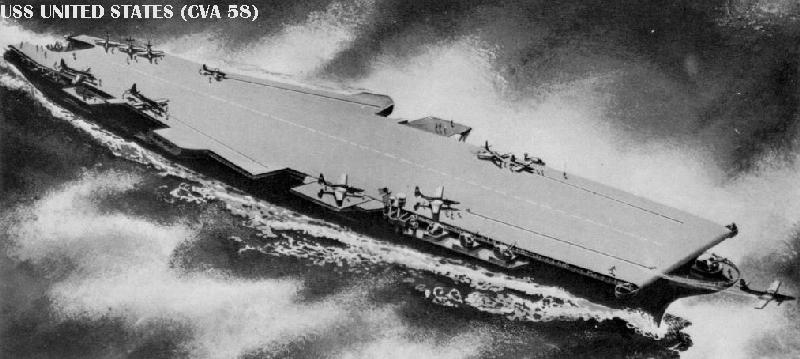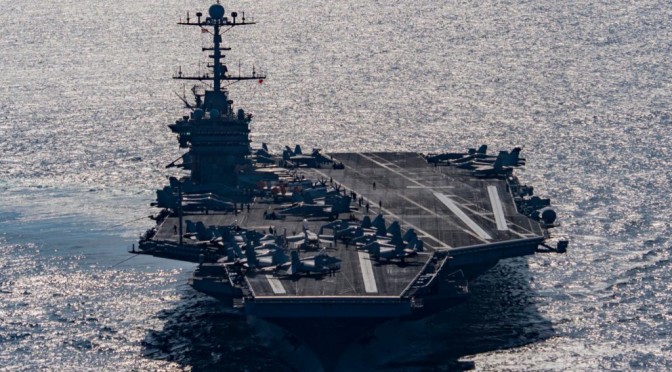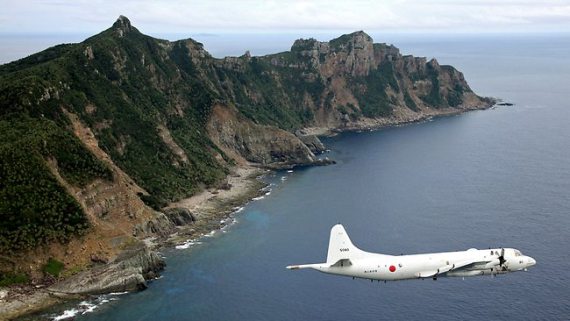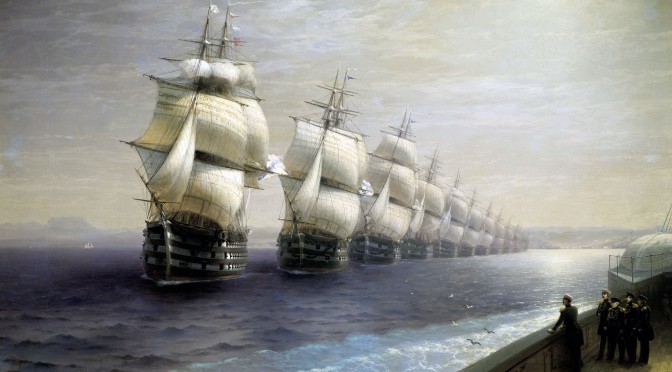By Steven Wills
The arguments deployed in the latest debate over the aircraft carrier’s place in the U.S. Navy’s force structure have a familiar ring. That is perhaps because they have been very similar criticisms in every carrier debate going back to the 1920’s. While every weapon system undergoes re-evaluation and criticism over its service life, the large aircraft carrier has been the subject of four significant debates in the 20th and 21st century. Each has involved questions of the large carrier’s cost relative to the capability it delivers; the range of the carrier’s embarked air wing; and the vulnerability of the carrier itself to threats. In each case, the carrier and its embarked air wing have proved reliable, cost effective ordnance delivery systems in comparison with other naval weapon systems. The carrier’s air wing has at times been deficient in range and/or combat capability, but has upgraded to meet threats. The carrier has always been a very vulnerable type of warship due to the nature of its mission. Decision-makers have repeatedly accepted this vulnerability as an acceptable price for the capabilities the large deck flattop delivers. The present carrier debate has all of these same components, and while not all solutions to the present round of carrier criticisms are not in place, they are in sight and can be achieved. The aircraft carrier replaced the battleship as the principal capital ship of the world’s navies because, “It was far more capable than the battleship of inflicting damage on the enemy.”[1] Some other naval weapon system will eventually replace the aircraft carrier, but that platform and payload combination has yet to manifest its presence on, above or beneath the world’s oceans.
[otw_shortcode_button href=”https://cimsec.org/buying-cimsec-war-bonds/18115″ size=”medium” icon_position=”right” shape=”round” color_class=”otw-blue”]Donate to CIMSEC![/otw_shortcode_button]
The first U.S. carrier controversy dates to the decades of the 1920’s and 1930’s when the carrier first entered the world’s navies in its present recognizable form and in numbers beyond mere experiment. The main concern was that the carrier’s air wing was too weak and short-ranged to prevent an attack by a powerful surface force. A force of battleships and cruisers might travel a distance longer than the range of the carrier’s aircraft under the cover of darkness when carrier aircraft could not then operate.
There were also concerns that the first two significant carriers, USS Lexington (CV 2), and USS Saratoga (CV 3), were too large, too expensive (at $45 million dollars a unit without aircraft), and placed too much of the fleet’s air strength in too few platforms. The concept of a hybrid “flying deck cruiser” with cruiser size guns and an airwing optimized for scouting was proposed as an augment to the carrier fleet to counter these concerns.[2]

These concerns, however, evaporated with technological advances. The range of carrier aircraft increased over the 1930’s and that change eliminated the threat from surface forces approaching in hours of darkness. New U.S. carriers of the Yorktown class were much less expensive at $19 million a copy, but still supported air wings in size and capability approaching the larger, previous Lexington class. House Naval Affairs Committee Chairman Carl Vinson confirmed the carrier as the fleet’s new capital ship even before Pearl Harbor in the signing statement of the $8.5 billion dollar Two Ocean Navy Act of July 1940. He stated, “The modern development of aircraft has demonstrated conclusively that the backbone of the Navy today is the aircraft carrier. The carrier, with destroyers, cruisers and submarines grouped around it is the spearhead of all modern naval task forces.”[3]
The second carrier controversy began in the immediate aftermath of the carrier’s greatest triumph. The end of the Second World War and with it the navies of the fascist powers caused many to question the need for carrier aviation in what appeared to be a new age of predominately atomic warfare. Notable Army Air Corps (now Air Force) and Army officers dismissed the aircraft carrier as unnecessary in an age of intercontinental aircraft like the B-36 bomber. Army Chief of Staff General Omar Bradley dismissed the “super” (large) carrier as the Navy’s tool to employ long-range bombers, a role already covered by the Air Force.[4] Air Force Chief of Staff General Hoyt Vandenberg said the carrier was of “low military value” and that “land based air power was of far greater military usefulness.”[5] Defense Secretary Louis Johnson, with the strong support of President Harry Truman, cancelled the first postwar “supercarrier” in May 1949 based largely on these Army and Air Force opinions. Attempts by Navy Department civilians to discredit the B-36 before Congressional hearings further damaged the Navy’s case for the aircraft carrier in the emerging Cold War.
The carrier survived its second controversy thanks to the Korean War. The conflict on the Korean peninsula demanded close air support for ground troops desperately in need of firepower to drive back larger North Korean formations. This was a mission that the Air Force had generally ignored and allowed to degrade in the aftermath of World War 2. The Navy was used to providing air support to Marine units from aircraft carriers and quickly demonstrated its ability to step up for post-World War 2 “small wars.” Naval strikes from carriers were crucial in repelling the initial North Korean attack and carrier-based Navy and Marine Corps aviators eventually flew 41% of all air combat missions in the Korean War.[6] The carrier would go on to similar strike missions in the Vietnam War and in other U.S. power projection efforts. Even President Truman came around to the carrier’s combat potential and endorsed the Forrestal class super carriers with the first commissioning in 1954.[7]

The most recent carrier controversy had its roots in post-Vietnam war budget cuts and a misunderstanding of the operational design for the emerging Soviet Navy of the early 1970’s. The projected $2 billion dollar price tag of the fifth nuclear-powered carrier (the eventual USS Theodore Roosevelt) made the Carter administration reluctant to authorize such an expensive vessel.[8] The Congressional Budget Office produced documents suggesting that the carrier was not “survivable” in a modern battle, which further suggested that a $2 billion dollar price tag for a failed weapon system was the wrong choice.[9] Finally, NATO advocates in the Carter administration such as Robert Komer wanted the U.S. for focus the bulk of its defense expenditures on the defense of the Fulda gap against the possibility of Soviet invasion. The Navy’s chief task in this mission was sea control and protection of the vital supply lines between North America and Europe. Komer believed large carrier battle groups were unneeded for this mission and the large outlays required for their construction were better spent on land warfare equipment.[10] Some former officers including former USS Nimitz commander Admiral Eugene Carroll, and CIA director and naval strategist Admiral Stansfield Turner joined the chorus of carrier doubters. Politicians such as Colorado Senator Gary Hart, who in his book America Can Win and in other writings proclaimed, “like the battleship the carrier replaced, its magnificence cannot nullify basic changes in the nature of war at sea.”
Ironically, this carrier controversy disappeared more rapidly than the previous two. Significant analysis from disparate sources appeared in defense of the large flattop and its capabilities. Future Chief of Naval Operations Admiral Carlisle Trost in conjunction with the CNA Corporation produced the 1978 Sea Based Air Platform Study at the behest of Congressional Committees, “at loggerheads over whether the next carrier would have a nuclear or conventional power plant.”[11] Large nuclear and smaller conventional carriers designed to operate vertical take off and landing (VSTOL) aircraft were studied. While all three types of carrier had positive attributes identified by the study, the 30 year life cycle cost of the nuclear carrier was only slightly more than that of its conventional equal. Both carried significantly more aircraft than the smaller VSTOL ship. Based on this, according to naval tactics expert (then executive assistant to Under Secretary of the Navy James Woolsey), Captain Wayne Hughes, “With total ownership costs so close, it was reasonable to let the Navy’s preference be decisive. The next year Congress authorized a CVN!”[12]

John Lehman’s 1978 Aircraft Carriers, The Real Choices came to similar conclusions. Lehman examined seven basic points concerning sea-based aviation including: (1) what should sea-based aviation do?; (2) what can land-based air do better?; (3) how vulnerable are carriers?; (4) how many carriers are needed and what do they cost?; (5) how essential is nuclear propulsion for carriers?; (6) what are the practical options for size of future carriers?; and (7) how will VSTOL technologies affect future air power at sea? [13] Lehman found that sea-based aviation was a useful companion to its land based equivalent in that carrier aviation allowed the US greater geographic freedom to strike targets out of range of land-based air. Larger carriers were less vulnerable (historically) than their smaller cousins. The examples of large carriers surviving significant accidents (USS Forrestal and USS Enterprise) was important to this determination. Enterprise survived the equivalent of six Soviet SSN-3 cruise missile hits but resumed flight operations several hours later.[14]
Lehman was also an analyst who contributed to the Sea Plan 2000 analysis that first recommended 15 aircraft carriers as the minimum number needed by the US for both peacetime presence and minimal wartime operations against the Soviet Union. His suggestion for carrier strength of 13-17 carriers as the right number was in keeping with the general Navy assumptions of the time. Lehman, like the analysts who completed the Sea-Based Air Platform study found that nuclear carrier costs over the lifespan of the ship were within 2.5% to 3% those of a large conventional carrier and worth the Navy’s investment.[15] Lehman’s analysis determined a number of significant problems associated with small carriers. Accident rates were significant in smaller ships. Over a 10 year period the smaller Midway class carrier suffered 10% greater flight deck accidents than did the larger flattops.[16] Larger carriers with 4 catapults could also put more aircraft in the air at a faster rate; a capability crucial to defense of the flattop against surprise air attack. Lehman also suggested that VSTOL aircraft held little promise of further advance and while many could be carried on a smaller aircraft carrier, their utility in high end warfare was limited.
Finally, naval intelligence efforts in the late 1970’s and early 1980’s determined that the Soviet Navy likely had no plans to significantly interdict NATO convoys to Europe in the event of a major war. U.S. taps on Soviet naval communications pods revealed that the Soviets most important fleet mission was defense of their ballistic missile submarines based in “bastions” within the Barents Sea. This intelligence confirmed what analysts like Robert Herrick and CNA’s James McConnell had said throughout the 1970’s; that the Soviet’s had a generally defensive naval strategy.[17] This revelation gave further support to the idea that an offensive naval strategy was the best choice for naval conflict with the USSR. An offensive war concept was better suited to large carrier operations than the small flattops conceived to fight antisubmarine and anti-surface battles in defense of NATO resupply convoys. Together the analysis and intelligence work of the late 1970’s and early 1980’s effectively ended the third carrier crisis of the 20th century.

The present carrier “crisis” contains many elements of these past examples. As in the 1920’s, the current carrier air wing is too small and lacks the range necessary to effectively strike opponents without facing a significant response. Many assumptions in the wake of the First Gulf War of 1991 suggested that future conflicts would be joint and combined air/ground task force operations against rouge states and non-state actors around the Eurasian littoral. Land-based air support would always be nearby and plentiful. These assumptions, however, should be discarded in a new age where peer competitors and non-state actors exist side by side and carrier-based aviation may be the only component in the air component commander’s arsenal.
The budget is again tight as it was after the Second World War and in the late 1970’s. The nation cannot sustain another military buildup funded on debt and no miracle growth in the economy appears certain on the horizon. The other services will fight with equal vigor to keep their own assets and popular social spending programs are hard to curtail, let alone eliminate. The Navy will need creative ways to get more out of the carriers it has. The carrier force must be re-balanced with some regions getting more than others dependent on the availability of land-based aviation. Some carriers could be placed in reserve status in order to ensure that those that remain are fully capable of high-end warfare against peer competitors.
The range and strike capability of current carrier-based aircraft is substantially diminished in comparison with its late Cold War incarnation. Today’s carrier air wing boasts 62 aircraft as compared with the 80-90 aircraft wing of the Cold War.[18] The carrier air wing will need to be increased with longer range, manned or unmanned aircraft to return it to the capability of the late 1980’s/early 1990’s.
Despite these problems, no one weapon system appears poised to relieve the carrier as the primary U.S. naval offensive component. A mass of missile-shooting ships and submarines is required to achieve the same level of consistent ordnance delivery provided by a large carrier. Surface ship missile shooters may be affected by adverse weather conditions. An increase in the percentage of U.S. strike capability concentrated in submarines could result in equally rapid opponent advances in antisubmarine warfare. It is very difficult to retain technological advantages given the global diffusion of knowledge enabled by the information age. Future naval victories are more likely to depend on superior operational and tactical employment of existing platforms and payloads rather than technological superiority.
The carrier remains a flexible, re-configurable platform with significant potential going into the 21st century. The U.S. may have to reduce the overall number of large carriers it actively employs and tailor that presence to specific geographic areas where carrier-based airpower is an advantage. There has not yet been an active demonstration of a superior strike platform/system as there was in the war games of the 1920’s and 1930’s. The large U.S. aircraft carrier will likely survive this fourth challenge to its place atop the naval hierarchy, but it must increase the range and capability of its attendant air wing to achieve this goal.
Steve Wills is a retired surface warfare officer and a PhD student in military history at Ohio University. His focus areas are modern U.S. naval and military reorganization efforts and British naval strategy and policy from 1889-1941.
[otw_shortcode_button href=”https://cimsec.org/buying-cimsec-war-bonds/18115″ size=”medium” icon_position=”right” shape=”round” color_class=”otw-blue”]Donate to CIMSEC![/otw_shortcode_button]
[1] David K. Brown, Nelson to Vanguard, Warship Design and Development, 1923-1945, Annapolis, Md, Naval Institute Press, 2000, p. 39.
[2] John Kuehn, Agents of Innovation, The General Board and the Design of the Fleet that Defeated the Japanese Navy, Annapolis, Md, The Naval Institute Press, 2008, pp. 102, 103.
[3] 8 1/2 BILLION IS VOTED FOR 1,500 WARSHIPS; House Passes Bill for Great Carrier Force and Escorts, With Battleships Left Out, New York Times, June 18, 1942.
[4] Jeffrey Barlow, From Hot War to Cold, The U.S. Navy and National Security Affairs, 1945-1954, Standford, CA, Stanford University Press, 2009, p. 212.
[5] Ibid.
[6] George W. Baer, One Hundred Years of Seapower, Stanford, CA, Stanford University press, 1994, p. 328.
[7] Paul B. Ryan, First Line of Defense, The U.S. Navy Since 1945, Stanford, CA, The Hoover Institute Press, 1981, p. 14.
[8] Ryan, p. 104.
[9] Congressional Budget Office, The U.S. Sea Control Mission: Forces, Capabilities, and Requirements, June 1977.
[10] Frank Leith Jones, Blowtorch, Robert Komer, Vietnam and American Cold War Strategy, Annapolis, Md, Naval Institute Press, 2013, pp. 251, 252.
[11] Wayne P. Hughes, Jr., (2002) Navy Operations Research. Operations Research. p. 7.
[12] Ibid.
[13] John F. Lehman, Aircraft Carriers, The Real Choices, Washington D.C., Center for International and Strategic Studies, Georgetown University, 1978, p. 11.
[14] Ibid, p. 41.
[15] Ibid, p. 52.
[16] Ibid, p. 57.
[17] Christopher Ford and David Rosenberg, The Admiral’s Advantage, U.S. Navy Operational Intelligence in World War 2 and the Cold War, Annapolis, MD, Naval Institute Press, 2005, p. 79.
[18] Jerry Hendrix. “The Future of the Aircraft Carrier looks Dim,” War on the Rocks, October 21, 2015.








